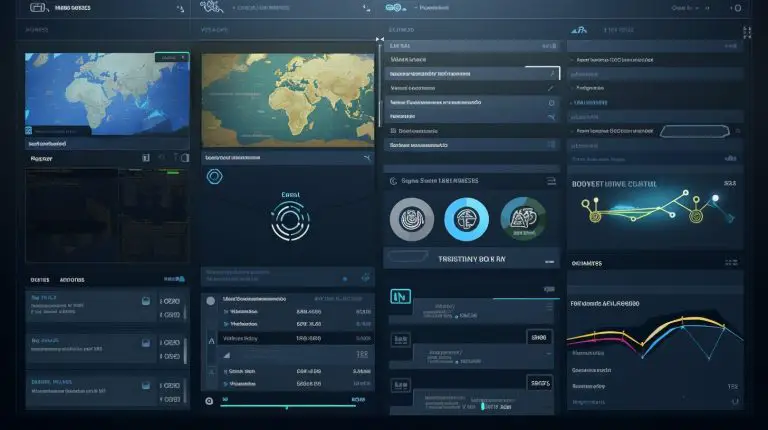Exploring Suricata: Your Guide to Network Security
Welcome to my guide on Suricata, an open-source detection engine developed by the Open Information Security Foundation (OSIF). In this article, I will provide you with a comprehensive overview of Suricata’s features, benefits, use cases, and its role in network security. Whether you are a security professional or an enthusiast, this guide will give you valuable insights into Suricata and its potential to enhance your network security defenses.
Key Takeaways:
- Suricata is an open-source detection engine that functions as both an IDS and IPS.
- It offers deep packet inspection capabilities and is compatible with various operating systems.
- Suricata provides cost-effective network security solutions and valuable insights into security events.
- The tool has a strong developer community, regular updates, and extensive documentation.
- Suricata can be deployed in various use cases, from enhancing SIEM detections to network traffic analysis.
What is Suricata and How Does It Work?
Suricata is an open-source detection engine used for network security. It functions as both an IDS and IPS, providing a comprehensive solution for detecting and preventing threats. With its rule set and signature language, Suricata identifies and blocks attacks, ensuring the security of your network.
One of the key features of Suricata is its compatibility with various operating systems. Whether you’re using Windows, Mac, Unix, or Linux, Suricata can be seamlessly integrated into your network environment.
Suricata’s deep packet inspection capabilities make it a powerful tool for network security. By examining the contents of network packets, Suricata can detect malicious activity and take immediate action. This enables you to respond quickly to threats and minimize potential damage.
Suricata’s rule set and signature language are essential elements of its functionality. These rules and signatures define the behaviors and characteristics of known threats, allowing Suricata to recognize and block them. With regular updates and community contributions, Suricata remains up to date with emerging threats and evolving attack techniques.
Suricata’s ability to function as both an IDS and IPS sets it apart from other network security tools. It not only identifies threats but also takes action to prevent them, providing comprehensive protection for your network.
Suricata’s user-friendly interface and powerful capabilities make it an indispensable asset for network security professionals. Whether you’re a small business owner or an enterprise-level organization, Suricata can be tailored to meet your specific security needs.
Suricata’s Key Features:
- Functionality as both an IDS and IPS
- Compatibility with various operating systems
- Deep packet inspection capabilities
- Regular rule set and signature updates
To illustrate Suricata’s capabilities, consider the following example:
Imagine a scenario where an attacker attempts to exploit a vulnerability in your network. Suricata’s deep packet inspection quickly detects the malicious activity and blocks the attacker’s connection. This swift action prevents the attacker from gaining unauthorized access and ensures the security of your network.
Suricata’s effectiveness in identifying and preventing attacks makes it a valuable asset in any network security strategy. Its compatibility, rule set, deep packet inspection, and prevention capabilities combine to create a robust defense against a wide range of threats.
Benefits of Suricata for Network Security
Suricata offers a range of benefits for network security, making it a valuable tool for organizations looking to strengthen their defenses. Here are some key advantages of using Suricata:
- Cost-Effective Solution: Suricata is an open-source detection engine, which means it is freely available for use. This makes it a cost-effective option for organizations with limited budgets.
- Valuable Insights: Suricata provides valuable insights into network security events by detecting and alerting on potential threats. This helps organizations stay proactive in identifying and mitigating security risks.
- Multi-Threaded Architecture: Suricata’s multi-threaded architecture allows it to utilize multiple cores simultaneously. This improves performance and load balancing, enabling efficient processing of network traffic.
- Strong Developer Community and Support: Suricata benefits from a strong developer community that actively contributes to its development, updates, and documentation. Organizations can rely on the community for assistance and guidance.
- Enhanced SIEM Integration: Suricata can enhance Security Information and Event Management (SIEM) systems by providing valuable output for detection rules and processes. This integration enables organizations to have a comprehensive view of their network security events.
Suricata is a versatile tool that combines affordability with advanced security features. Its open-source nature, multi-threaded architecture, and integration capabilities make it a compelling choice for organizations seeking effective network security solutions.
By leveraging the benefits of Suricata, organizations can enhance their network security posture and defend against various cyber threats.
Next: Key Features of Suricata
Key Features of Suricata
Suricata, the open-source network security detection engine, offers a range of powerful features that make it an invaluable tool for protecting your network. Let’s explore some of its key features:
- Functionality as IDS and IPS: Suricata is designed to serve as both an Intrusion Detection System (IDS) and an Intrusion Prevention System (IPS). This means it can not only detect potential threats but also take action to prevent them from compromising your network security.
- Deep Packet Inspection: With its deep packet inspection capabilities, Suricata can analyze network traffic at a granular level. This enables it to identify malicious activities and anomalies, such as malware infections, suspicious network connections, and unauthorized access attempts.
- Multi-threaded Architecture: Suricata leverages a multi-threaded architecture, allowing it to efficiently utilize multiple cores and process a high volume of network traffic. This enhances performance and enables effective load balancing, ensuring your network remains secure without sacrificing speed.
- Compatibility with Various Operating Systems: Suricata is compatible with a wide range of operating systems, including Mac, Windows, Linux, and Unix. Regardless of your network infrastructure, Suricata can seamlessly integrate into your environment and provide robust security.
- Advanced Rule Set and Signature Language: Suricata offers extensive support for advanced rule sets and signature languages. This allows you to tailor the detection and prevention capabilities to your specific network security needs. With precise rules and signatures, Suricata can effectively identify and mitigate threats.
Suricata’s feature-rich nature makes it a versatile solution for network security. By leveraging its IDS and IPS capabilities, deep packet inspection, multi-threaded architecture, compatibility with various operating systems, and advanced rule set support, you can strengthen your network defenses and protect your valuable data.
“Suricata’s multi-threaded architecture and deep packet inspection capabilities ensure robust and efficient network security, making it a vital tool for modern organizations.”
Use Cases for Suricata
Suricata, as an open-source network security tool, offers a range of use cases that help protect and enhance network environments. Here are some key areas where Suricata can be leveraged:
- Enhancing SIEM Detections: Suricata can be used as a lightweight Intrusion Detection System (IDS) in conjunction with Security Information and Event Management (SIEM) platforms. By integrating Suricata’s detection capabilities, organizations can augment their SIEM systems and improve the overall accuracy and effectiveness of threat monitoring.
- Network Traffic Baselining and Analysis: Suricata generates valuable data that can be utilized for network traffic baselining and analysis. By analyzing the network traffic and patterns, organizations can establish baselines for normal behavior and identify anomalous or suspicious activities. This helps in detecting potential threats and ensuring the security of the network.
- Integration with SIEM Tools: Suricata’s logs and alerts can be seamlessly integrated into SIEM tools for enhanced analysis and monitoring. This integration enables security teams to have a consolidated view of network security events and helps in streamlining the incident response process.
These use cases highlight the versatility and value that Suricata brings to network security. By leveraging its capabilities, organizations can strengthen their security posture, detect and prevent threats, and ensure the integrity and availability of their network infrastructure.
To visualize the application of Suricata in network security, refer to the image below:
Suricata’s use cases provide valuable insights and detection capabilities to secure network environments by improving SIEM detections, analyzing network traffic, and integrating with SIEM tools for enhanced analysis and monitoring.
Suricata Installation and Configuration
Installing and configuring Suricata is an essential step in leveraging its network security capabilities. Whether you’re using Mac, Windows, Linux, or Unix, Suricata can be easily installed on your preferred operating system.
Before proceeding with installation, it’s important to consider the system requirements based on your intended use and server specifications. This ensures optimal performance and compatibility.
Once Suricata is successfully installed, the next crucial step is the configuration process. Suricata needs to be tailored to meet the specific network needs and requirements. This involves defining detection rules, alert settings, and other parameters to align with your security strategy.
It is recommended to start with Intrusion Detection System (IDS) mode during the initial phase. This helps in testing and validating Suricata’s capabilities without directly interfering with the network traffic. Once the desired outcomes are achieved and confidence is built, transitioning to Intrusion Prevention System (IPS) mode is advisable to actively block and prevent threats.
Regular updates to the rules engine are important as new findings and investigations progress. Keeping the rules up to date ensures effective detection and prevention of emerging threats.
By following the installation and configuration best practices, you can unlock the full potential of Suricata as a robust network security tool.
Best Practices for Suricata Deployment
When deploying Suricata for network security, it is essential to follow best practices to ensure optimal performance and accuracy. By implementing the following recommendations, you can make the most of Suricata’s capabilities and enhance your network protection:
- Start in IDS Mode for Testing: Begin by deploying Suricata in Intrusion Detection System (IDS) mode to validate its functionality and effectiveness. This testing phase allows you to fine-tune the system before transitioning to Intrusion Prevention System (IPS) mode.
- Tune the System to Your Network: Every network has unique characteristics, and it’s important to configure Suricata to align with your specific requirements. Adjust the rule sets, thresholds, and detection parameters to minimize false positives and false negatives, enhancing the accuracy of threat detection.
- Update the Rules Engine Regularly: The threat landscape is constantly evolving, and it’s vital to keep Suricata’s rules engine up to date with the latest findings and investigations. Stay informed about emerging threats and apply relevant updates to ensure the detection of new attack vectors.
- Include False Positives and Whitelists: To prevent unnecessary alerts and reduce false positives, incorporate known safe network traffic signatures into Suricata’s rules engine. Whitelisting trusted sources and benign activities helps improve accuracy and streamlines incident response.
Following these best practices will optimize Suricata’s deployment in your network environment, enhancing its overall effectiveness in detecting and preventing threats.
“By starting in IDS mode for testing, tuning the system to the network’s needs, and continuously updating the rules engine, Suricata can deliver accurate threat detection and prevention capabilities.” – Suricata Best Practices Expert
Suricata Performance and Comparison with Snort
Suricata is widely recognized for its exceptional performance in network security, leveraging its multi-threaded architecture to maximize the utilization of multiple cores. This advanced architecture allows Suricata to efficiently process massive amounts of data without compromising on the number of implemented rules.
When comparing Suricata with Snort, another renowned open-source network security tool, Suricata gains a significant advantage due to its multi-threading capabilities. This advantage empowers Suricata to deliver superior performance in terms of detecting and preventing network threats.
“Suricata’s multi-threaded architecture enables it to process comprehensive network traffic with ease, ensuring optimal performance and efficiency in threat detection and prevention.”
The utilization of multiple cores ensures that Suricata can handle heavy network traffic loads while maintaining consistent and reliable performance. This capability is particularly crucial in high-bandwidth networks, where real-time threat detection and response are essential.
Snort vs. Suricata: A Performance Comparison
In a head-to-head performance comparison, Suricata outshines Snort due to its advanced multi-threading capabilities. While Snort traditionally processes network traffic in a single-threaded manner, Suricata’s ability to leverage multiple cores allows for faster and more efficient packet analysis.
Suricata’s multi-threading capabilities enable it to perform at a higher level, offering improved scalability and faster response times compared to Snort. This advantage translates into Suricata’s ability to handle more complex network environments and higher network loads while maintaining optimal performance.
Maximizing Network Security Performance
By harnessing Suricata’s advanced multi-threading architecture, network administrators can ensure optimal network security performance. Leveraging Suricata’s capabilities to its full potential allows for efficient threat detection and prevention, providing enhanced protection for critical network assets.
“Suricata’s exceptional performance empowers organizations to strengthen their network security infrastructure and respond swiftly to potential threats.”
To visualize the exceptional performance of Suricata, refer to the table below:
| Suricata Performance | Snort Performance |
|---|---|
| Efficient utilization of multiple cores | Single-threaded processing |
| Superior scalability and response times | Limitations in handling higher network loads |
| Optimal performance in high-bandwidth networks | Performance degradation in high-bandwidth scenarios |
As demonstrated, Suricata’s superior multi-threading capabilities position it as a highly effective solution for enterprises seeking top-notch network security performance.
As we continue to dive deeper into Suricata, the upcoming section will cover training and educational resources available to help users further enhance their understanding of this exceptional network security tool.
Suricata Training and Educational Resources
If you’re looking to enhance your skills in Suricata, there are various training courses and educational resources available to help you get started. Whether you’re a beginner or an experienced professional, these resources can provide valuable insights and knowledge to enhance your understanding of Suricata and its capabilities.
The Open Information Security Foundation (OISF) and other organizations offer online courses, workshops, and comprehensive documentation on Suricata. These resources cover a wide range of topics, including network security monitoring, intrusion detection, and Suricata deployment in enterprise environments. By taking advantage of these training opportunities, you can gain the necessary skills to effectively utilize Suricata for network security purposes.
In addition to formal training, there are also extensive documentation and user guides available that provide step-by-step instructions on Suricata installation, configuration, and troubleshooting. These resources serve as valuable references for both beginners and experienced users, ensuring you have the knowledge and guidance needed to make the most of Suricata.
Benefits of Suricata Training:
- Acquire an in-depth understanding of Suricata’s functionality and capabilities.
- Learn best practices for Suricata installation, configuration, and rule management.
- Enhance network security monitoring and intrusion detection skills.
- Stay up-to-date with the latest developments and features of Suricata.
- Gain hands-on experience through practical exercises and real-world scenarios.
By investing time and effort in Suricata training, you can become proficient in this powerful detection engine, strengthening your network security measures and effectively mitigating potential threats.
Remember, continuous learning and improvement are essential in the ever-evolving field of network security. By leveraging the available online courses, workshops, and documentation, you can stay ahead of the curve and maximize the potential of Suricata.

Conclusion
In conclusion, Suricata is a powerful open-source detection engine that serves as an IDS and IPS, offering a wide range of benefits for network security. Its lightweight nature, deep packet inspection capabilities, and multi-threaded architecture make it a valuable tool in identifying and preventing threats.
Suricata can be applied in various use cases, including enhancing SIEM detections and network traffic baselining. With its strong developer community, regular updates, and extensive documentation, Suricata is both reliable and user-friendly. By following best practices in installation, configuration, and rule management, Suricata can effectively strengthen network security measures.
Overall, Suricata is a robust solution for network security, providing advanced features and superior performance. Its capabilities are comparable to other popular open-source tools, making it a competitive choice in the market. Whether you’re a small business or an enterprise, Suricata offers the versatility and reliability you need to safeguard your network.
FAQ
What is Suricata?
Suricata is an open-source detection engine developed by the Open Information Security Foundation (OSIF). It functions as both an intrusion detection system (IDS) and intrusion prevention system (IPS) for network security.
What are the benefits of using Suricata for network security?
Suricata offers several benefits, including cost-effectiveness, valuable insights into network security events, multi-threaded architecture for improved performance, and compatibility with various operating systems.
What are the key features of Suricata?
Suricata has key features such as functioning as both an IDS and IPS, deep packet inspection capabilities, multi-threaded architecture, and support for advanced rule sets and signature language.
What are the use cases for Suricata?
Suricata has various use cases in network security, such as enhancing detections from SIEM platforms, network traffic baselining and analysis, and integrating logs and alerts into SIEM tools for enhanced monitoring.
How do I install and configure Suricata?
Suricata can be installed on various operating systems and requires configuration based on specific network needs. It is recommended to start with IDS mode for testing and validation, and updates to the rules engine can be made as investigations progress.
What are the best practices for deploying Suricata?
Best practices for Suricata deployment include starting in IDS mode for testing, tuning the system to the network’s needs, and continuously updating the engine with false positives and whitelists to improve accuracy.
How does Suricata perform compared to Snort?
Suricata has excellent performance due to its multi-threaded architecture, allowing efficient utilization of multiple cores. This gives it an advantage over Snort, another popular open-source network security tool.
Are there any training and educational resources available for Suricata?
Yes, there are various resources such as online courses, workshops, and documentation provided by the Open Information Security Foundation (OISF) and other organizations to help users get started with Suricata.
Source Links
- About the Author
- Latest Posts
Mark is a senior content editor at Text-Center.com and has more than 20 years of experience with linux and windows operating systems. He also writes for Biteno.com


